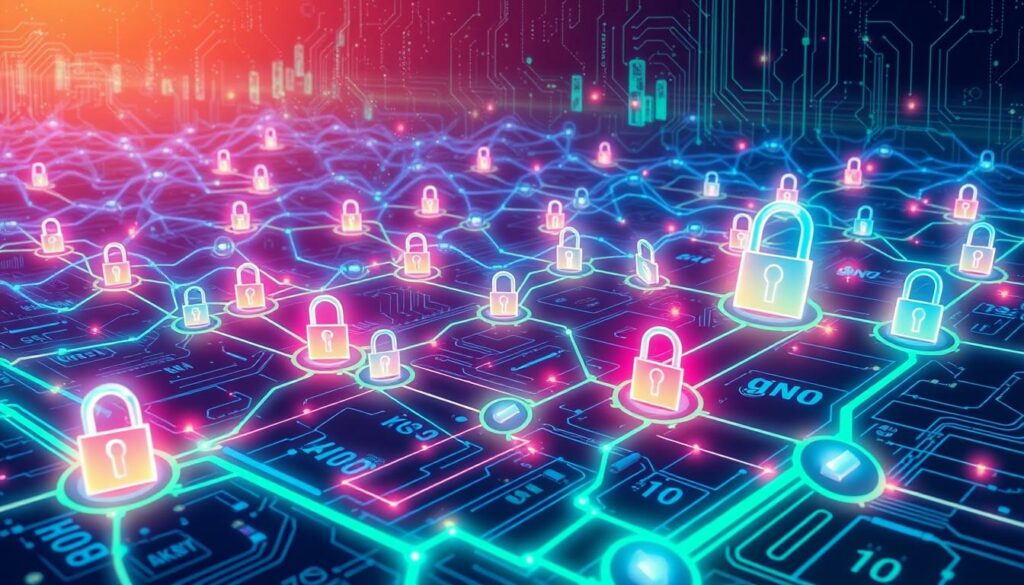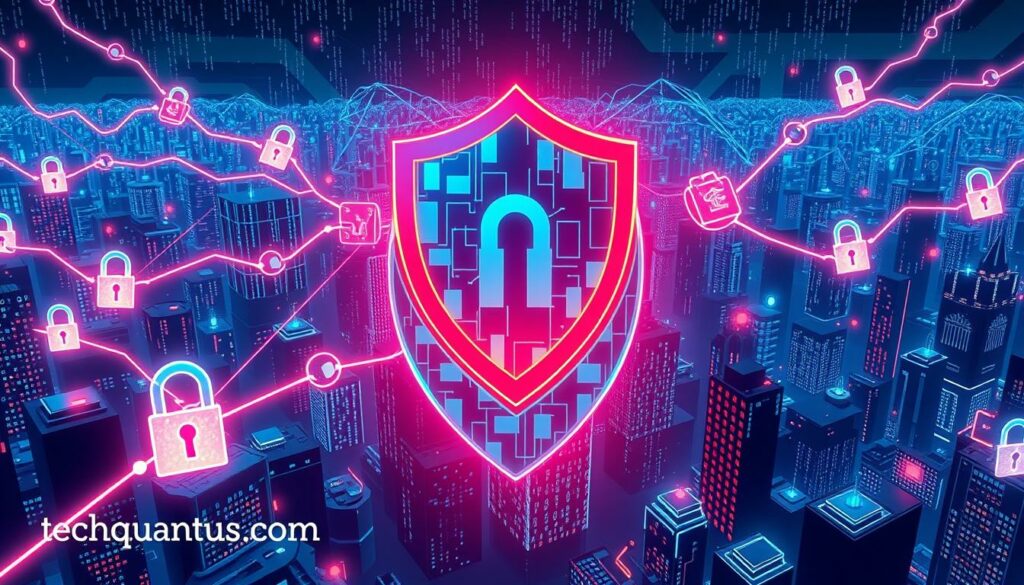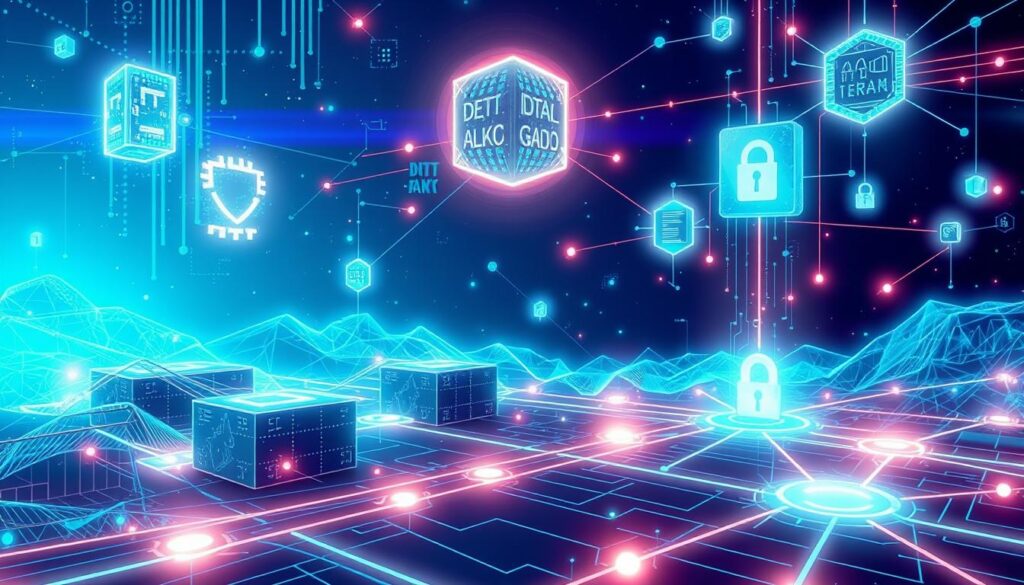The use of blockchain technology is changing the game in IT security. It offers a new way to protect data and reduce risks. Companies are looking at blockchain as a way to keep their information safe.
This technology creates a secure, shared system. It helps keep data safe from cyber threats. For businesses, understanding blockchain is key to staying safe online.
Key Takeaways
- Blockchain technology is reshaping IT security protocols.
- Emphasizes improved data integrity and protection mechanisms.
- Offers innovative solutions to combat cyber threats.
- Enhances transparency through decentralized processes.
- Identifies key trends in the future of digital security.
Introduction to Blockchain Technology
Blockchain technology is a game-changer for managing data today. It uses decentralized systems to make transactions safe and clear. This tech creates a digital ledger that keeps data safe and sound.
But blockchain is more than just for money. It’s used in supply chains, healthcare, and finance too. It helps track things and keep records honest. In today’s world, we need to trust digital stuff more than ever, especially with cyber threats.
Ooredoo Group just showed how big tech is getting in the region. They got a big loan to improve their tech and meet new demands. This move shows the MENA region is really into tech, especially data centers.
The future of blockchain technology looks bright. It’s helping us work better together and make things more efficient. As we use more digital stuff, knowing about blockchain will become even more important. Check out more info on blockchain technology to see how it can help.
The Importance of IT Security Today
In today’s digital world, IT security is more important than ever. Businesses face a huge rise in cyber threats that put sensitive info and key systems at risk. As tech gets better, hackers get smarter, making old ways of protecting data less useful.
Data breaches cost a lot of money. Studies show the average breach can cost millions. This hurts a company’s finances, reputation, and trust with customers. Without strong IT security, fixing these issues takes longer and costs more.
It’s key to have solid data protection plans. This means using the latest security tech, checking for weak spots often, and teaching employees about dangers. Threats come from many places, like phishing, ransomware, and insiders.
When you’re trying to keep your digital world safe, here are some big threats to watch out for:
- Phishing Scams
- Ransomware Attacks
- Insider Threats
- DDoS (Distributed Denial of Service) Attacks
- Malware
Boosting IT security is not just a must; it’s a smart investment in your company’s future. By focusing on protecting data, you keep your assets safe, keep customers trusting you, and follow the law. Fighting cyber threats is a constant job, using new tech and best practices to stay ahead.
| Cybersecurity Threat | Impact | Prevention Strategy |
|---|---|---|
| Phishing Scams | Confidential data theft | Employee training and awareness |
| Ransomware Attacks | Financial loss and data inaccessibility | Regular backups and updates |
| Insider Threats | Data breaches from within | Access control measures |
| DDoS Attacks | Service disruption | Load balancing and redundancy |
| Malware | System corruption | Antivirus software and firewalls |
Knowing about IT security today helps your company protect its data better. Make sure to keep your info safe to create a secure place to work in a world full of cyber threats.
What is Blockchain and How Does it Work?
The blockchain mechanism is a game-changer for secure digital transactions. It’s a system where data is spread across many nodes, not one server. This makes data safer and more reliable.
Transactions start with validation, needing encryption and a block. Miners then solve math problems to check these transactions. Once done, the block is added to the chain, making it permanent.
Consensus mechanisms keep everyone on the same page. Methods like Proof of Work and Proof of Stake are used. They boost security and build trust, key for digital transactions.
Blockchain is a big deal for fighting data breaches and fraud. It offers secure, tamper-proof records. This makes it great for finance, healthcare, and more.
Blockchain keeps getting better, making digital interactions safer. For instance, a lawsuit against DexCom, Inc shows the need for secure and transparent transactions.
The Role of Smart Contracts in IT Security
Smart contracts are changing how we handle agreements in IT security. They are self-executing contracts on a blockchain. This means they can automate processes and make agreements happen without middlemen.
They cut down on fraud and mistakes because they don’t need humans. This is especially important in today’s complex IT world.
As data breaches and hacking grow, companies are looking at smart contracts for security. They make transactions clear, making it tough for hackers to hide their actions.
Here are some key benefits of using smart contracts for security:
- Automation: It cuts down on human errors.
- Compliance Enhancement: It keeps up with laws automatically.
- Transaction Transparency: Every transaction is recorded, making it hard for hackers.
Statistics show how vital smart contracts are today. In 2024, crypto hacks caused more losses than ever before. This highlights the need for secure agreements.
Even though smart contract hacks went up, they’re still a small part of all hacking. This shows we’re getting better at finding and fixing vulnerabilities.
| Metric | 2023 | 2024 | Percentage Change |
|---|---|---|---|
| Total Crypto Hack Losses | $1.230 billion | $2.114 billion | 72% |
| Smart Contract Exploits | Increase | 182% | N/A |
| Access Control Breaches | Increase | 218% | N/A |
| Hacking Incidents | 44 | 131 | 197% |
Benefits of Blockchain in IT Security
Blockchain technology brings big advantages to IT security. It changes how we handle and keep safe sensitive data. Its special features make security better by offering networks that are spread out. This helps keep data safe, open, and stops changes without permission.
Decentralization and Data Integrity
One big blockchain benefit is being spread out. It doesn’t rely on one place, but on many nodes. This makes it hard for hackers to get to the data because there’s no single target. Every piece of data is checked and agreed upon, making it more reliable and true.
Because there’s no single boss, it’s hard for bad guys to mess with the data.
Enhanced Transparency and Traceability
Blockchain makes things clear with its public ledger. It keeps track of all transactions in a way that can be checked. This helps companies follow rules and check their data easily. Users can see where an asset has been, building trust and responsibility.
Being able to see changes helps manage data better, which is key for good security. Learn more about blockchain’s role in making things clear here.
Immutability: Protecting Against Data Tampering
Immutability is a big deal with blockchain. Once data is on a blockchain, changing or deleting it is very hard without everyone agreeing. This keeps data safe from being messed with, making sure it stays true over time.
Companies using blockchain lower the risk of bad changes, making users feel safer.
| Feature | Description | Impact on IT Security |
|---|---|---|
| Decentralization | Data stored across multiple nodes | Reduces points of failure and breaches |
| Transparency | Public ledger accessible to all | Enhances audit trails and trust |
| Immutability | Unchangeable transaction records | Prevents data tampering and fraud |
Innovation and Blockchain Trends in IT Security
In the fast-changing world of tech, blockchain trends lead the way, changing how companies handle IT security. These new ideas are making old security methods better by adding new layers of protection. Decentralized finance (DeFi) apps, built on blockchain, offer safe and clear financial services.
Cybersecurity innovations use smart contracts to make things automatic, cutting down on mistakes and threats. When companies add blockchain to their security plans, they get stronger against cyber attacks. New digital identity systems also use blockchain, giving users more control over their data and making sure it’s real and safe.

Blockchain and future IT solutions working together bring big changes. For example, blockchain’s unchangeable ledgers help keep things honest and trackable, stopping data tampering. Companies using these tools not only get safer but also win trust from their customers.
The finance world shows how important these tech steps are for keeping data safe. As banks and other financial places use blockchain for transactions, they cut down on fraud and unauthorized access. This move shows how blockchain is becoming key for strong IT security in many fields.
The Impact of Cybersecurity Threats on Businesses
Cybersecurity threats are a big worry for businesses today. With more tech use, companies face new challenges. Financial losses from hacks can be huge, hurting costs and reputation.
Research shows the average cost of fixing a ransomware attack in healthcare was USD $2.57 million in 2024. It’s key for leaders to know these costs.
Ransomware and other threats hurt finances and operations. They can damage customer trust and harm long-term relationships. A company’s response to these threats can shape its future.
With threats always changing, companies must keep updating their IT security. Attacks are getting smarter, making strong defenses essential. Businesses should look into guidelines on ransomware protection to stay safe.
| Year | Average Cost of Recovery (USD) | Percentage of Healthcare Organizations Affected by Ransomware | Percentage of Organizations Compromised |
|---|---|---|---|
| 2023 | 2,200,000 | 60% | 34% |
| 2024 | 2,570,000 | 67% | 34% |
Being proactive in facing threats can make a big difference. As cybersecurity issues spread, businesses and leaders must focus on security. This is the only way to meet new challenges head-on.
How Blockchain Can Combat Cybersecurity Threats
In today’s world, cybersecurity threats are growing fast. Blockchain offers big benefits for improving security. It helps find and stop fraud early. With blockchain, companies can protect their data and digital assets better.
Potential Use Cases in Identifying Breaches
Blockchain is key in spotting threats early. It uses a network where every transaction is recorded and can’t be changed. This lets companies watch activities in real-time and catch problems fast.
Blockchain’s openness helps track transactions, making sure they’re real. This boosts security and fights off threats.
Reducing Fraud through Tokenization
Tokenization is a big help in fighting fraud. It turns important data into safe tokens. These tokens can only be used in certain places, making it hard for hackers to get in.
This method not only cuts down fraud but also keeps customer info safe. It’s a key part of keeping data secure today. You can learn more about how blockchain improves data safety.

| Aspect | Blockchain Solutions | Traditional Methods |
|---|---|---|
| Data Integrity | Immutable records enhance security | Vulnerable to alterations |
| Fraud Prevention | Tokenization reduces unauthorized access | Relies on strong passwords and firewalls |
| Audit Trails | Transparent and easily verifiable | Can be manipulated, reducing trust |
| Monitoring | Real-time insights for threat detection | Often delayed and less efficient |
Using blockchain makes your cybersecurity stronger. It helps you deal with the digital world more confidently.
IT New Trends: The Future of Secure Digital Identity
The future of secure digital identity is changing fast, thanks to blockchain technology. With more data breaches and identity theft, managing identities well is key. Decentralized identity solutions are becoming popular, making user privacy better and interactions smoother.
These changes give people more control over their data. This could change how companies deal with their customers.
2023 saw a big problem with money laundering and fraud, with over $3.1 trillion lost. This shows we need strong digital identity systems. Now, companies are using AI and machine learning to check identities better and fight crime.
Blockchain helps make digital identities secure by not needing one central place. Smart contracts could make identity management even better. As these technologies grow, businesses will use them to keep transactions safe and make things easier for users.
The future looks bright for secure digital identity. Governments are looking at blockchain for things like secure voting. This could lead to better data protection and more trust in our systems.
We can also expect to see more open supply chains thanks to blockchain. The market for fighting financial crime is set to grow a lot from 2024 to 2031. This shows how important it is to manage identities well.
| Trend | Description | Impact |
|---|---|---|
| Decentralized Identity Solutions | Empower users to control their personal information. | Increased user confidence and privacy. |
| Smart Contracts | Automated processes for identity verification. | Efficient and secure transactions. |
| AI Integration | Enhancing detection of identity fraud. | Improved accuracy in identity management. |
| Blockchain Governance | Innovative applications such as secure voting. | Enhanced transparency and trust in governance. |
| Supply Chain Transparency | Blockchain ensures traceability of products. | Ethical sourcing and accountability. |
These changes are promising for the future of secure digital identity. They show how important it is to manage identities well in today’s tech world.
Conclusion
Blockchain technology is a big deal for IT security’s future. It’s all about being decentralized, which means more security. This tech also makes it easier to track and protect data.
Blockchain’s ability to keep data safe is unmatched. It’s a key player in making technology more secure. This is especially true as cyber threats keep getting worse.
Blockchain is changing the game in cybersecurity. It’s getting better and better, tackling new challenges head-on. Soon, it will be a big part of many industries, making them safer and more efficient.
By understanding blockchain, you can make your digital world safer. It’s a game-changer for keeping information secure. As it grows, so will our defenses against cyber threats.
So, what’s next? Blockchain will keep getting better, helping us fight off cyber attacks. It’s a bright future for IT security, thanks to blockchain.
FAQ
What is blockchain technology?
Blockchain is a system that keeps digital transactions safe and secure. It uses many computers to record data, making sure it can’t be changed later. This keeps the data safe and trustworthy.
How does blockchain improve IT security?
Blockchain makes IT security better by being decentralized. This means there’s no single point that can be hacked. It also can’t be changed once it’s set, and it’s very transparent. This helps with following rules and checking things out.
What are smart contracts and how do they relate to IT security?
Smart contracts are like digital agreements that run on their own. They make sure things are done right and fairly. This helps avoid mistakes and fraud.
Why is IT security increasingly important today?
Today, there are more threats to computer security than ever. Companies need strong ways to protect their data. This is to stop hackers and keep their reputation safe.
What are some current trends in blockchain technology affecting IT security?
Right now, blockchain is being used for things like digital money and better ways to check who you are. These new uses are making IT security better at fighting off cyber threats.
Can blockchain help in identifying cybersecurity breaches?
Yes, blockchain can help find cyber threats early. It keeps a clear, unchangeable record of all transactions. This makes it easier to spot and fix problems fast.
What is tokenization and how does it help reduce fraud?
Tokenization turns sensitive data into safe tokens. These tokens can only be used in certain places. This reduces fraud by keeping the real data safe.
How is secure digital identity management evolving with blockchain?
Blockchain is changing how we manage digital identities. It’s moving towards solutions that are more private and secure. This meets the needs of both individuals and companies in our digital world.
Source Links
- Huawei Peer-Recognized as a 2024 Gartner® Peer Insights™ Customers’ Choice for Enterprise Wired and Wireless LAN Infrastructure
- Bitcoin Poised for New All-Time Highs This Year, Analyst Predicts—With a Warning
- Quantum Computing Basics for Beginners: A Simplified Guide
- I Use Prompt Engineering Templates That Work Across ChatGPT, Gemini, Claude & Grok
- I Use Small Business AI Stack: Affordable Tools to Automate Support, Sales, Marketing
- Remote Work Productivity Tips: Maximize Efficiency
- The AI Snitch: Why Grassing Out Colleagues, Even for “Efficiency,” Backfires
Related posts:
 Secure Your Data: Setup Your Cloud Security Steps
Secure Your Data: Setup Your Cloud Security Steps
 The Rise of Zero Trust: Why It’s the Future of IT Security
The Rise of Zero Trust: Why It’s the Future of IT Security
 The Impact of Quantum Computing on Cybersecurity
The Impact of Quantum Computing on Cybersecurity
 The Role of Quantum Cryptography in Future Cybersecurity
The Role of Quantum Cryptography in Future Cybersecurity
 How to Automate Cybersecurity Threat Detection Using AI
How to Automate Cybersecurity Threat Detection Using AI
 CISSP Domain 3: Security Architecture and Engineering
CISSP Domain 3: Security Architecture and Engineering
